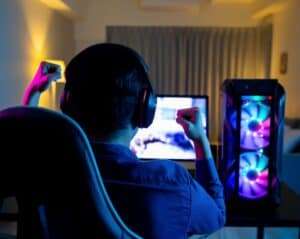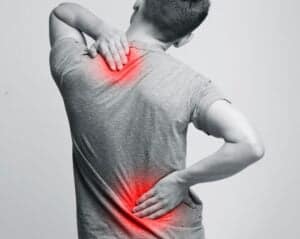Are gaming chairs good for your back? This is a good question, but shall we limit the back issue with the gaming chair or look at it holistically.
Gaming chairs can provide certain benefits for your back if used correctly. However, it’s important to note that the effectiveness of a gaming chair in promoting good back health can vary depending on the individual and the specific chair.
Some gaming chairs are designed with ergonomic features such as adjustable lumbar support, adjustable armrests, and high backrests that aim to provide better support and comfort for your back while gaming. These features can help maintain proper posture and reduce strain on your back, especially during long gaming sessions.
However, it’s crucial to remember that simply owning a gaming chair does not guarantee good back health. It’s essential to use the chair properly and maintain good sitting habits.
Contents
- 1 Here are some general tips for maintaining good posture and back health while using a gaming chair.
- 2 "Level up your gaming experience with a healthy back, because a strong spine supports both your victories and your adventures."
- 3 Here are the ten most frequently used medical terminologies associated with back pain.
- 4 About Us
Here are some general tips for maintaining good posture and back health while using a gaming chair.

1) Adjust the chair: Make sure the chair is properly adjusted to fit your body. Ensure that your feet are flat on the floor or supported by a footrest and your knees are at a 90-degree angle. The chair’s height, recline, and lumbar support should be adjusted to support your natural spinal curve.
2) Sit upright: Maintain a neutral posture with your back straight and shoulders relaxed. Avoid slouching or hunching forward, as it can strain your back and neck.
3) Eye-level monitor position: Adjust the monitor or screen to be at eye level so you don’t have to strain your neck by looking up or down. Position the screen at a comfortable distance to avoid eye strain.
4) Maintain neutral wrist and forearm position: Keep your wrists straight and supported while using the keyboard or mouse. Consider using wrist supports or an ergonomic keyboard and mouse to prevent wrist strain.
5) Use a cushion or lumbar roll: If your gaming chair lacks proper lumbar support, use a cushion or a small lumbar roll to support the natural curve of your lower back.
6) Customize your setup: Adjust your gaming setup according to your body’s needs. Consider using ergonomic accessories like keyboard trays, adjustable monitor stands, or a gaming desk with proper height and dimensions.
7) Take breaks and stretch: It’s essential to take regular breaks from sitting, especially during long gaming sessions. Stand up, stretch, and move around to alleviate muscle tension and promote circulation. Engage in regular exercise and stretching to strengthen your core muscles and promote overall back health.
8) Manage Stress: Emotional stress and tension can manifest physically, including in the form of back pain. Practice stress management techniques such as relaxation exercises, meditation, or engaging in activities that help you relax and unwind.
9) Stay hydrated: Proper hydration is essential for maintaining the health of your spinal discs, which act as shock absorbers for your spine. Drink an adequate amount of water throughout the day to keep your discs hydrated and maintain their function.
10) Sleep on a supportive mattress: After a long gaming session, when you feel like relaxing on your mattress, your mattress plays a crucial role in supporting your back during sleep. Use a mattress that provides adequate support and promotes proper spinal alignment. The ideal mattress firmness may vary depending on your specific needs and preferences; you may seek expert advice to select your mattress.
11) Pay attention to pain signals: Pay attention to your body’s signals. If an activity or movement increases your back pain, listening to your body and avoiding or modifying that activity is important.
Remember that each person’s body is distinct, and what may be effective for one individual might not yield the same results for someone else; it’s always a good idea to consult with a healthcare professional for personalized advice. While a gaming chair can offer back support, it’s important to remember that adopting good gaming postures and maintaining healthy habits is vital to building a strong and resilient back for an immersive gaming experience. Combining a supportive chair, proper posture, and healthy habits will improve overall well-being and enhance your gaming enjoyment.
"Level up your gaming experience with a healthy back, because a strong spine supports both your victories and your adventures."
For gamers who already have back pain, they should not ignore any symptoms. They should not rely too much on homecare remedies and must consult a Medical expert (Orthopaedic or Physiotherapist or both). Before you go to a healthcare professional, it’s worth considering spending some time to understand commonly used medical terminologies associated with back pain. Knowing these terminologies will help to have better communication with a Medical expert.
Here are the ten most frequently used medical terminologies associated with back pain.

1) Spondylosis: A general term used to describe age-related changes in the spine, such as degenerative changes in the discs and joints.
2) Herniated disc: Also known as a slipped or ruptured disc, it occurs when the soft inner core of a spinal disc protrudes through the outer layer, potentially causing nerve compression and pain.
3) Sciatica: A condition characterized by pain that radiates along the sciatic nerve, usually from the lower back through the buttocks and down the back of the leg.
4) Spinal stenosis: The narrowing of the spinal canal, which can put pressure on the spinal cord and nerves, leading to pain, numbness, and weakness.
5) Spondylolisthesis: A condition in which a vertebra slips out of its normal position, often occurring in the lower back, causing pain and nerve compression.
6) Facet joint syndrome: A condition in which the facet joints, located on the posterior side of the vertebrae, become inflamed or damaged, leading to pain and limited range of motion.
7) Degenerative disc disease: The natural wear and tear of the spinal discs over time, resulting in decreased disc height, disc bulging, or thinning, which can cause pain and stiffness.
8) Lordosis: The normal inward curvature of the lower back, but excessive or abnormal lordosis can contribute to lower back pain.
9) Kyphosis: An excessive outward curvature of the thoracic spine, which can lead to a hunched or rounded upper back.
10) Osteoarthritis: A degenerative joint disease characterized by the breakdown of cartilage in the joints, including those in the spine, leading to pain, stiffness, and limited mobility.
These are just a few of the many medical terms associated with back pain; feel free to engage in a conversation with your medical expert and seek further clarification on any other terms they may have used. This will enable you to gain a deeper understanding and expand your knowledge on the subject.
I hope we have looked at “Are gaming chairs good for your back?” from all dimensions rather than looking at it from the gaming chair’s perspective.
We invite you to share your thoughts and insights and any health tips you incorporate to relax your back with fellow gamers. Your contributions can positively impact the gaming community and help others enhance their well-being while gaming.
To know more about us, click the below link

